LASIK with PlanoScan 2000: accurate, stable and safe for treating high ametropia
No correction factor is needed with the PlanoScan 2000.
ALGARVE, Portugal — Laser in situ keratomileusis (LASIK) with the PlanoScan 2000 (Technolas 217 C; Bausch & Lomb Surgical, Claremont, Calif.) appears to be an accurate, stable and safe method to treat high ametropias, according to Prof. Joaquim Neto Murta, MD, of Coimbra, Portugal, who spoke at the European Society of Cataract and Refractive Surgeons meeting here.
“We started using the Technolas 217 C in 1997,” he said. “This first program tended to undercorrect and necessitated a correction factor related to the optical zone. We applied a 10% correction factor for an optical zone of 6 mm, a 12% correction factor for an optical zone of 5.5 mm and so on accordingly.”
A new algorithm, which was introduced a year later, allowed a reduction of 30% ablation depth, especially for astigmatic treatment. However, it still necessitated a 10% correction factor for high myopes.
The results obtained with the PlanoScan 2000, which Prof. Murta introduced in his surgery a year ago, show an even greater reduction of the ablation depth for all myopic values. No correction factor needs to be applied (Figure 1).
Results
Prof. Murta treated 297 eyes with PlanoScan 2000. They were divided in three groups. Group 1 (162 eyes) had myopia between 1 D and 6 D, with a spherical equivalent of –3.9 +1.2. Group 2 (102 eyes) ranged between 6 D and 10 D, with a spherical equivalent of –7.9 +1.1. Group 3 (33 eyes) had myopia higher than 10 D, with a spherical equivalent of –12.1 +1.8.
The mean age of patients was 33.7 +5.4 years (ranging from 21 to 49). The follow-up was longer than 2 months.
No correction factor was applied. All LASIK flaps were 160 mm and were performed with a Hansatome microkeratome (Bausch & Lomb Surgical). The ablation zone ranged between 4.5 and 6 mm. All patients were administered steroids for 10 days postoperatively.
“All patients in the three groups had a hyperopic shift between 1 and 2 months,” Prof. Murta said. “Between month 3 and month 6, refraction became more stable, with a slight myopic regression.” (Figures 2, 3, 4)
At 2 months, in group 1, uncorrected visual acuity (UCVA) was 20/20 in 59% of eyes, more than 20/40 in 94% of eyes and less than 20/40 in 6% of eyes. In the same group, at 6 months, UCVA had improved and was 20/20 in 85% of eyes, more than 20/40 in 95% of eyes and less than 20/40 in 5% of eyes (Figure 5).
In group 2, at 2 months, UCVA was 20/20 in 34% of eyes, more than 20/40 in 90% of eyes and less than 20/40 in 10% of eyes. There was again an improvement at 6 months, when 62% of eyes achieved 20/20, 94% achieved more than 20/40 and 6% less than 20/40 (Figure 6).
In group 3, where preoperative myopia was higher than 10 D, UCVA was 20/20 at 2 months in 12% of eyes, more than 20/40 in 70% and less than 20/40 in 30%. At 6 months, 33% had achieved 20/20, 67% had more than 20/40 and 33% had less than 20/40 (Figure 7).
At 3 months, best spectacle corrected visual acuity remained unchanged in 91% of eyes in group 1, 81% of eyes in group 2 and 58% of eyes in group 3. In group 1, 4% of eyes lost one line and 5% gained one line. In group 2, 7% lost one line, 8% gained one line and 4% gained two lines. In group 3, 5% lost two lines, 11% lost one line, 16% gained one line and 11% gained two lines (Figure 8).
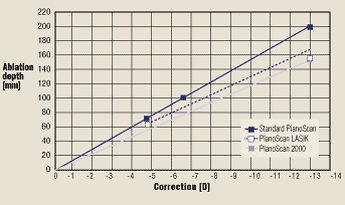 Comparison of ablation depths for a 5-mm optical zone with three different programs (Standard PlanoScan, PlanoScan LASIK and PlanoScan 2000). | 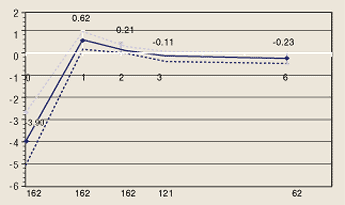 Mean (±SD) subjective spherical equivalent of patients in group 1 (–1 D to –6 D) over time. |
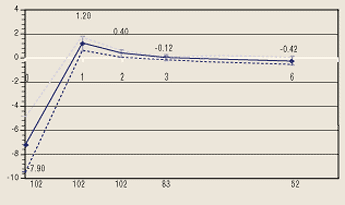 Mean (±SD) subjective spherical equivalent of patients in group 2 (–6 D to –10 D) over time. | 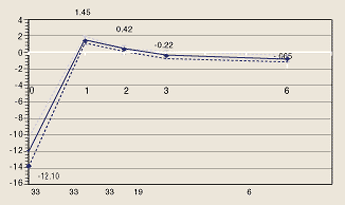 Mean (±SD) subjective spherical equivalent of patients in group 3 (greater than –10 D) over time. |
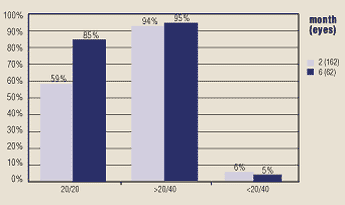 UCVA achieved by group 1 at 2 months (162 eyes) and 6 months (62 eyes) postop. | 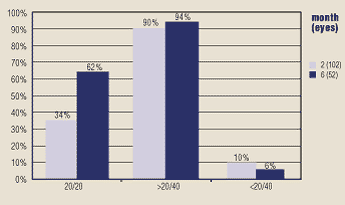 UCVA achieved by group 2 at 2 months (102 eyes) and 6 months (52 eyes) postop. |
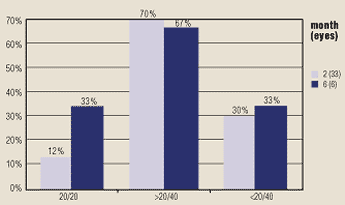 UCVA achieved by group 3 at 2 months (33 eyes) and 6 months (six eyes) postop. | 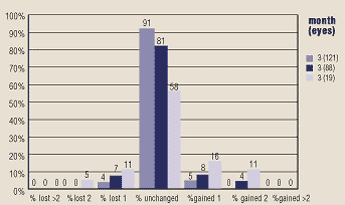 Change in best spectacle corrected visual acuity 3 months after LASIK in group 1 (121 eyes), group 2 (83 eyes) and group 3 (19 eyes). |
For Your Information:
- Prof. Joaquim Neto Murta, MD, can be reached at the Department of Ophthalmology, University Hospital, 3000 Coimbra, Portugal; (351) 2-39-701-182; fax: (351) 2-39-403-046; e-mail: Jmurta@mail.telepac.pt. Dr. Murta has no direct financial interest in any of the products mentioned in this article, nor is he a paid consultant for any companies mentioned.
- Bausch & Lomb Surgical can be reached at 555 W. Arrow Highway, Claremont, CA 91711; (800) 423-1871; fax: (909) 399-1525.
